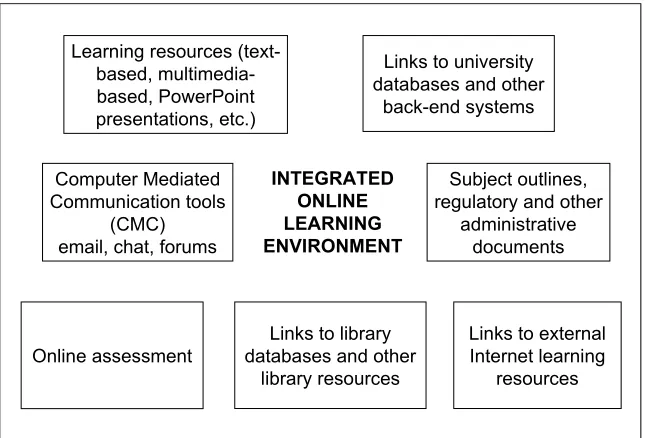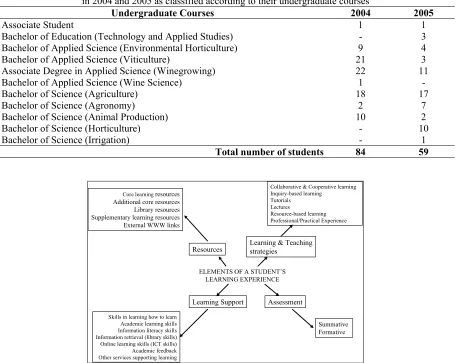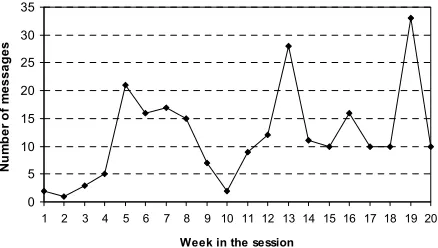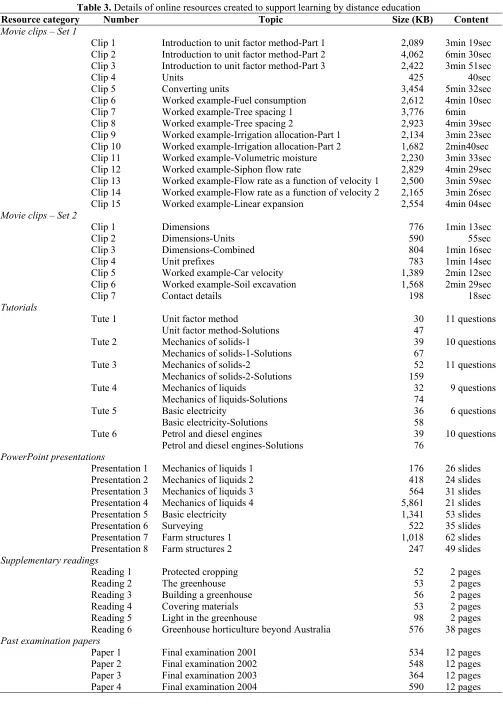Value of online resources for learning by distance education
Siva Sivapalan1,2 and
Peter Cregan1
1School of Agricultural and
Veterinary Sciences Charles Sturt University Australia
2Current address: School of Urban
Development
Queensland University of Technology
Australia
sivapala@bigpond.com; pcregan@csu.edu.au
Introduction
An audit of a large regional University offering courses with an applied focus identified that in terms of learning and teaching activities, it was meeting the needs of its local region while providing support to the professions both within the State and nationally (AUQA 2004). The audit also found that in general terms, students reported very positively on their learning and teaching experiences and were appreciative of supportive teaching staff. The subject-based online discussion fora, which allow for discussion between and among students and staff, are found to be a highly positive supplement to other forms of support (AUQA 2004). Students studying by distance, in particular, find participation in the forum very useful since it lessens the sense of isolation and allows them to communicate with fellow students studying both internally and by distance. Other features of the online environment, such as online submission of assignments, are also valued by students. The University has a priority to promote an institutional climate which values and supports flexible teaching and learning practices to enhance learning (CSU 2003). This has been achieved by, among other things, development of online subject outlines and promotion of the use of the University’s Learning Resources Bank. Palaskas and Muldoon (2003) noted that the current online environment at the University is characterized by the capability to involve students in online forum discussions, deliver learning resources online and to provide online administrative services (Figure 1).
INTEGRATED ONLINE LEARNING ENVIRONMENT
Subject outlines, regulatory and other
administrative documents Computer Mediated
Communication tools (CMC) email, chat, forums
Learning resources (text-based, multimedia-based, PowerPoint presentations, etc.)
Links to university databases and other
back-end systems
Online assessment
Links to library databases and other
library resources
Links to external Internet learning
resources
Figure 1. Components of an integrated online learning environment at the University (adopted from Palaskas and Muldoon 2003)
First year subject
The subject under study was one of the 56 subjects offered by the School at the University to undergraduate students in different courses. It is offered in the Autumn (first) session of each year and recommended to students in their first year of study. The teaching of the subject was shared by four academics and supported by a Maths Skills Advisor and the practical component was assisted by a Technical Officer. The subject covered topics such as Unit factor method, Mechanics of solids, Mechanics of liquids, Heating and cooling, Basic electricity, Surveying, Petrol and diesel engines, and Farm structures. The subject aimed to develop skills to relate theoretical principles to practical solutions, think logically in solving problems, develop teamwork in problem solving, and use mathematical techniques in everyday calculations. Each student enrolled in this subject received a mail package which contained printed materials including a Subject Outline and Modules (1-8) with notes and readings. The students completed three written assignments (Assignments 1-3, each worth 10 marks) during the session and sat for a closed book examination (worth for 70 marks) towards the end of the session. The subject had an online subject outline which provided direct links to access various resources such as email
communication with the Subject Coordinator, subject forum, library, ‘EASTS’ (Electronic Assignment Submission and Tracking System), ‘OASIS’ (Online Assessment Submission Information System), ‘New Resources’ (Flexible Publishing Tool), etc.
Distance education students
In 2004, the University had 33,736 student enrolments of which approximately 71% through distance education mode (OPA 2004). A total of 84 students undertook the learning of the subject through distance education mode of study in Autumn Session of 2004 (Table 1). The student number in 2005 decreased to 59, primarily due to the recommendation of an alternative subject to those students in the Viticulture program by their course coordinator. The great diversity of backgrounds of these students should be taken into consideration when assessing their ability to learn a common subject. It should be noted that student learning by distance education is influenced by many factors as illustrated in Figure 2. Student performance in any assessment task will be a reflection of their exposure to these elements. The effect is rather cumulative and depends on the degree of their exposure to each element.
Table 1. Number of distance education students who studied the first year subject in 2004 and 2005 as classified according to their undergraduate courses
Undergraduate Courses 2004 2005
Associate Student 1 1
Bachelor of Education (Technology and Applied Studies) - 3
Bachelor of Applied Science (Environmental Horticulture) 9 4
Bachelor of Applied Science (Viticulture) 21 3
Associate Degree in Applied Science (Winegrowing) 22 11
Bachelor of Applied Science (Wine Science) 1 -
Bachelor of Science (Agriculture) 18 17
Bachelor of Science (Agronomy) 2 7
Bachelor of Science (Animal Production) 10 2
Bachelor of Science (Horticulture) - 10
Bachelor of Science (Irrigation) - 1
Total number of students 84 59
ELEMENTS OF A STUDENT’S LEARNING EXPERIENCE
Assessment
Summative Formative Learning Support
Skills in learning how to learn Academic learning skills Information literacy skills Information retrieval (library skills) Online learning skills (ICT skills) Academic feedback Other services supporting learning
Learning & Teaching strategies
Collaborative & Cooperative learning Inquiry-based learning
Tutorials Lectures
Resource-based learning Professional/Practical Experience
Resources
Core learning resources Additional core resources Library resources Supplementary learning resources External WWW links
Table 2. Student participation in Online Assessment Submission Information System (OASIS) Test Topic No. of questions No. of students No. of attempts
Test 1 Unit factor method 1 5 24 37
Test 2 Unit factor method 2 5 16 24
Test 3 Unit factor method 3 3 4 9
Test 4 Mechanics of liquids 1 10 7 16
Test 5 Mechanics of liquids 2 10 1 1
Test 6 Basic electricity 10 6 13
Test 7 Surveying 10 3 3
Test 8 Farm structures 10 2 2
Online resources
A range of online resources were created to support the learning of this subject in Autumn Session of 2005. OASIS was developed by the Division of Information Technology in conjunction with Centre for Enhancing Learning and Teaching (CELT) at Charles Sturt University. It is a user-friendly system whereby CSU staff can create online multiple choice tests to enhance their particular subjects and courses. OASIS allows students the choice to take a test at a time and place that suits them, and provides instant feedback on a particular topic or part of the course. Teaching staff can access students’ test results and thus assess group and/or individual student progress and course participation. Table 2 gives details of tests created for the students and their usage of these tests during the session. It should be noted that these test results were not counted towards the final score in the subject. This prompted the students to attempt these tests more than once.
Flexible Publishing is a tool that teaching staff can use to publish supplementary learning material on the University’s online web server (Plunket 2003). Flexible Publishing will enable teaching staff to upload a file to add to an online subject during session so that students have access to this material. Several multimedia supplementary resources as listed in Table 3 were created and published to the online environment using the Flexible Publishing tool. These supplementary materials do not affect assessment; however they aid learning and support in relation to the subject’s core learning materials (Figure 2). Movie clips were based on Windows Media Player, PowerPoint presentations were based on Microsoft PowerPoint, tutorial questions and solutions were based on Microsoft Word, and past examination papers and supplementary readings were based on Adobe Acrobat Reader. These resources were found under the link called ‘New Resources’ on the online subject outline for the use of all students enrolled in this subject. Students were able to access these resources any number of times with the option of just viewing on computer screen or saving in their local drive for future usage. File sizes were kept to a minimum to enable quicker downloading times.
Impact on learning
Results of students’ final score in assessment tasks in 2004 and 2005 were used to provide a preliminary indication of the impact of the usage of these online resources on their learning of the subject. Final scores in 2004 ranged from 2% to 88.9% with an average of 52.9% while in 2005 they
2004 and 2005 are presented in Figure 3. While there was 42.3% students scored less than 50% in their final score in 2004, this decreased to 35.3% students in 2005. On the other hand, 57.7% students scored more than 50% in 2004 and this figure increased to 62.7% in 2005. These preliminary findings are an indication of a positive response to the use of online resources by students in 2005.
0.0 5.0 10.0 15.0 20.0 25.0 30.0
1-10 11-20 21-30 31-40 41-50 51-60 61-70 71-80 81-90 91-100
Final score % s tu d e n ts
Figure 3. Percentage of students in different ranges of their final score in 2004 (unshaded bars) and 2005 (shaded bars)
The degree of student usage of online facilities was also evident from the number of postings in their subject online forum in 2005 as shown in Figure 4. The session officially started in Week 4 and examinations were held in Week 20. From Week 9 to Week 11, students attended Residential Schools. A total of 254 messages were posted on the forum by 35 individuals including 29 students. It is interesting to note that those students (except one) who posted more than 10 messages on the forum achieved a score which was greater than 74%. The highest scoring three students were also active users of the forum. In other words, 60% of the students who scored more than 70% in the final score were in fact regular users of the forum. A similar trend was also observed among the students who used OASIS tests. A classic example was where a student attempted a particular test a total of six times progressively scoring 20, 50, 60, 80, 90 and 100% correct in his/her answer. This proved to be a valuable exercise helping independent learning.
0 5 10 15 20 25 30 35
1 2 3 4 5 6 7 8 9 10 11 12 13 14 15 16 17 18 19 20
Week in the session
N u m b er o f m e ss ages
Table 3. Details of online resources created to support learning by distance education
Resource category Number Topic Size (KB) Content
Movie clips – Set 1
Clip 1 Introduction to unit factor method-Part 1 2,089 3min 19sec Clip 2 Introduction to unit factor method-Part 2 4,062 6min 30sec Clip 3 Introduction to unit factor method-Part 3 2,422 3min 51sec
Clip 4 Units 425 40sec
Clip 5 Converting units 3,454 5min 32sec
Clip 6 Worked example-Fuel consumption 2,612 4min 10sec
Clip 7 Worked example-Tree spacing 1 3,776 6min
Clip 8 Worked example-Tree spacing 2 2,923 4min 39sec
Clip 9 Worked example-Irrigation allocation-Part 1 2,134 3min 23sec Clip 10 Worked example-Irrigation allocation-Part 2 1,682 2min40sec Clip 11 Worked example-Volumetric moisture 2,230 3min 33sec Clip 12 Worked example-Siphon flow rate 2,829 4min 29sec Clip 13 Worked example-Flow rate as a function of velocity 1 2,500 3min 59sec Clip 14 Worked example-Flow rate as a function of velocity 2 2,165 3min 26sec Clip 15 Worked example-Linear expansion 2,554 4min 04sec
Movie clips – Set 2
Clip 1 Dimensions 776 1min 13sec
Clip 2 Dimensions-Units 590 55sec
Clip 3 Dimensions-Combined 804 1min 16sec
Clip 4 Unit prefixes 783 1min 14sec
Clip 5 Worked example-Car velocity 1,389 2min 12sec
Clip 6 Worked example-Soil excavation 1,568 2min 29sec
Clip 7 Contact details 198 18sec
Tutorials
Tute 1 Unit factor method 30 11 questions
Unit factor method-Solutions 47
Tute 2 Mechanics of solids-1 39 10 questions
Mechanics of solids-1-Solutions 67
Tute 3 Mechanics of solids-2 52 11 questions
Mechanics of solids-2-Solutions 159
Tute 4 Mechanics of liquids 32 9 questions
Mechanics of liquids-Solutions 74
Tute 5 Basic electricity 36 6 questions
Basic electricity-Solutions 58
Tute 6 Petrol and diesel engines 39 10 questions
Petrol and diesel engines-Solutions 76
PowerPoint presentations
Presentation 1 Mechanics of liquids 1 176 26 slides
Presentation 2 Mechanics of liquids 2 418 24 slides
Presentation 3 Mechanics of liquids 3 564 31 slides
Presentation 4 Mechanics of liquids 4 5,861 21 slides
Presentation 5 Basic electricity 1,341 53 slides
Presentation 6 Surveying 522 35 slides
Presentation 7 Farm structures 1 1,018 62 slides
Presentation 8 Farm structures 2 247 49 slides
Supplementary readings
Reading 1 Protected cropping 52 2 pages
Reading 2 The greenhouse 53 2 pages
Reading 3 Building a greenhouse 56 2 pages
Reading 4 Covering materials 53 2 pages
Reading 5 Light in the greenhouse 98 2 pages
Reading 6 Greenhouse horticulture beyond Australia 576 38 pages
Past examination papers
Paper 1 Final examination 2001 534 12 pages
Paper 2 Final examination 2002 548 12 pages
Paper 3 Final examination 2003 364 12 pages
Conclusion
A range of online resources were created to support the learning of a first year mathematics-based subject by distance education students in 2005. Results of students’ final score in the subject in 2004 and 2005 were compared to assess the impact of these online resources on their learning. There is clear evidence to suggest that the overall performance of students in 2005 was better than that in 2004. In addition, students who demonstrated an active participation in online activities also scored better marks compared with the rest of the students. Overall, the use of online resources has helped distance education students of learning of the first year subject and improved their performance in assessment tasks and final score of the subject. Hence the value of online resources for learning of a first year subject by distance education is high.
References
AUQA (2004) Report of an audit of Charles Sturt University. Australian Universities Quality Agency Audit, Report Number 27, November, Melbourne, Vic. Aziz, S.M. (2003) Online technology for enhancing first
year experience: a case study at the University of South Australia. In K. Placing (Ed) Proceedings of the
Improving Learning Outcomes Through Flexible Science Teaching Symposium. Sydney, NSW: UniServe Science, 102-103.
CSU (2003) Learning and teaching plan. Charles Sturt University, Wagga Wagga, NSW, March 2003, 1-13. OPA (2004) Pocket statistics 2004. Office of Planning and
Audit, Charles Sturt University.
Palaskas, T. and Muldoon, N. (2003) Learning and teaching at CSU: Moving towards increased flexibility. A discussion paper. Centre for Enhancing Teaching and Learning, CSU, Wagga Wagga, NSW, June, 1-31. Plunket, D. (2003) Flexible Publishing Wizard. Division of
Information Technology, Charles Sturt University, July 2003, Version 2, 1-24.
Schuhmacher, M. (2003) Integrating activities, e-environment and objective driven curriculum design in the learning environment. In K. Placing (Ed)
Proceedings of the Improving Learning Outcomes Through Flexible Science Teaching Symposium. Sydney, NSW: UniServe Science, 115.
Sivapalan, S. (2003) Value of multimedia approach for learning by distance education. In K. Placing (Ed)



